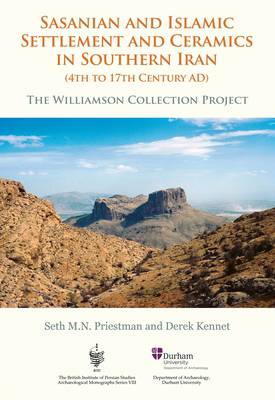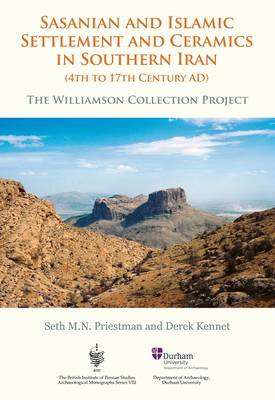
- Retrait gratuit dans votre magasin Club
- 7.000.000 titres dans notre catalogue
- Payer en toute sécurité
- Toujours un magasin près de chez vous
- Retrait gratuit dans votre magasin Club
- 7.000.0000 titres dans notre catalogue
- Payer en toute sécurité
- Toujours un magasin près de chez vous
Sasanian and Islamic Settlement and Ceramics in Southern Iran (4th to 17th Century Ad)
The Williamson Collection Project
Seth M N Priestman, Derek Kennet
171,95 €
+ 343 points
Description
This monograph presents new archaeological data on the economic development of southern Iran and the Persian Gulf coast from the Sasanian period to the end of the 17th century.
This monograph comprises the final publication of a study supported by the British Institute of Persian Studies and undertaken by Seth Priestman and Derek Kennet at the University of Durham. The work presents and analyses an assemblage of just under 17,000 sherds of pottery and associated paper archives resulting from one of the largest and most comprehensive surveys ever undertaken on the historic archaeology of southern Iran. The survey was undertaken by Andrew George Williamson (1945-1975), a doctoral student at Oxford University between 1968 and 1971, at a time of great progress and rapid advance in the archaeological exploration of Iran.
The monograph provides new archaeological evidence on the long-term development of settlement in Southern Iran, in particular the coastal region, from the Sasanian period to around the 17th century. The work provides new insights into regional settlement patterns and changing ceramic distribution, trade and use. A large amount of primary data is presented covering an extensive area from Minab to Bushehr along the coast and inland as far as Sirjan. This includes information on a number of previously undocumented archaeological sites, as well as a detailed description and analysis of the ceramic finds, which underpin the settlement evidence and provide a wider source of reference.
By collecting carefully controlled archaeological evidence related to the size, distribution and period of occupation of urban and rural settlements distributed across southern Iran, Williamson aimed to reconstruct the broader historical development of the region. Due to his early death the work was never completed. The key aims of the authors of this volume were to do justice to Williamson's remarkable vision and efforts on the one hand, and at the same time to bring this important new evidence to ongoing discussions about the development of southern Iran through the Sasanian and Islamic periods.
This monograph comprises the final publication of a study supported by the British Institute of Persian Studies and undertaken by Seth Priestman and Derek Kennet at the University of Durham. The work presents and analyses an assemblage of just under 17,000 sherds of pottery and associated paper archives resulting from one of the largest and most comprehensive surveys ever undertaken on the historic archaeology of southern Iran. The survey was undertaken by Andrew George Williamson (1945-1975), a doctoral student at Oxford University between 1968 and 1971, at a time of great progress and rapid advance in the archaeological exploration of Iran.
The monograph provides new archaeological evidence on the long-term development of settlement in Southern Iran, in particular the coastal region, from the Sasanian period to around the 17th century. The work provides new insights into regional settlement patterns and changing ceramic distribution, trade and use. A large amount of primary data is presented covering an extensive area from Minab to Bushehr along the coast and inland as far as Sirjan. This includes information on a number of previously undocumented archaeological sites, as well as a detailed description and analysis of the ceramic finds, which underpin the settlement evidence and provide a wider source of reference.
By collecting carefully controlled archaeological evidence related to the size, distribution and period of occupation of urban and rural settlements distributed across southern Iran, Williamson aimed to reconstruct the broader historical development of the region. Due to his early death the work was never completed. The key aims of the authors of this volume were to do justice to Williamson's remarkable vision and efforts on the one hand, and at the same time to bring this important new evidence to ongoing discussions about the development of southern Iran through the Sasanian and Islamic periods.
Spécifications
Parties prenantes
- Auteur(s) :
- Editeur:
Contenu
- Nombre de pages :
- 512
- Langue:
- Anglais
- Collection :
Caractéristiques
- EAN:
- 9798888570524
- Date de parution :
- 31-10-23
- Format:
- Livre relié
- Format numérique:
- Genaaid
- Dimensions :
- 210 mm x 297 mm

Les avis
Nous publions uniquement les avis qui respectent les conditions requises. Consultez nos conditions pour les avis.






